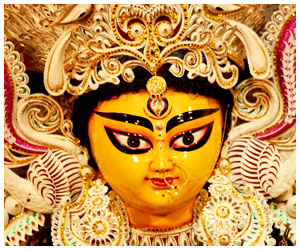
Considered as the sixth day from the new moon, Maha Shasthi marks the beginning of the staple Bengali festival, Durga Puja. It is the sole festival when people of Bengal all come together and dance with the melodious tunes of Dhak, a musical instrument, to welcome devi Durga with her four children to Her paternal house. Thus in to make this welcome indeed a grand one, many arrangements are made by the fellow Bengalis, the main amongst is the setting up of well decorated pandals wgere the idols are generally placed. Though arrangements start almost many months prior to the main festival but the actual mood of festivity is best highlighted from the evening of Maha Shasthi. Pandals starts getting crowded with all colourful souls. Everyone congregate on the pandal premise in order to participate in zeal and passion that is more to be disclosed in the coming four days. However the most visible site of this particular day is the inauguration of famous pandals which are generally inaugurated by some renowned artists, celebrities and ministers who invites various pandals.
However the most important aspect of this day is the unveiling of the face of the deity. This whole ritual is full of fascination and interest for many customs is associated with this ritual. The unveiling of the deity face is very famously known as the Bodhon of Devi Durga. Traditional and ethnic families of Bengal emphasize on Devi Bodhon as one the most important ceremonies of Durga Puja.
Another common aspect of the Maha Shasthi is, the day is entirely dedicated for last minute decorations and touch up. People visiting various pandals are sure to come across persons busy giving their utmost final strokes. The ambience takes a complete change for the roads and lanes are all well lighted and decorated with bright colors and lights. Even the music played very complement the lighting arranged. And the music of dhak is surely an added flavor. Thus a thrilling atmosphere is surely rendered.
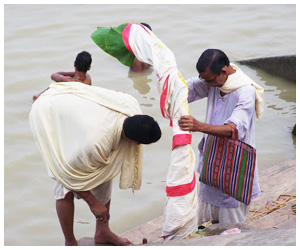
The day of Maha Shasthi is succeeded by the day of Maha Saptami which is the prime day of the five days long fiesta. It is the day when the famous ritual of “pran pratistha” which is infusing life into the idol is done. Once the “Pran pratistha” is completed, the “Kola Bou” or the “Nabapatrika” (a tender banana plant) is bathed. And after the auspicious bathing of the “Kola Bou”, it is wrapped with white colored saree which has a red border. The “Kola Bou” epitomises the “Pran Pratistha” into the devi idol. Nine plants are also worshipped which symbolize the nine forms of Devi Durga. Kalparambho and Mahasnan are predated by the grand Maha Saptami puja. Thus these customs seems to become an important occasion.
However there is a prevelant belief amongst Bengalis that the “Kola Bou” is the wife of Lord Ganesha, the son of the deity Durga. So following traditions and norms, the “Kola Bou” is duly placed right beside Lord Ganesha. Another important ritual observed on this day is the placing of a “ghot” or a brass pot, filled with water of pond or river, at the feet of Devi Durga. This sacred ghot is thus the epitome of the Goddess’s feet.
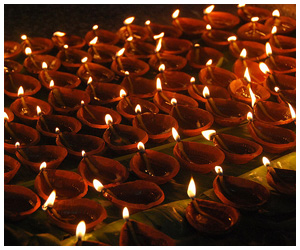
Maha Ashtami, the eighth day from the new moon, is the most significant day of the five days. It is the day when “Kola Bou” is worshipped. Many other important rituals are also witnessed some amongst them is the customary “Chandi Path”, “Kumari Puja” and “Aarati”. Thus Maha Ashtami is the auspicious day when Devi Durga killed Mahisasura, the demon. Hence the ceremony of Maha Ashtami continues from the early morning till the late night.
The evening of Maha Ashtami is the time when roads and pandals witness huge numbers of people. Traffic police works really hard to control the traffic. A number of people hire their own vehicles to see idols of different corners of the city of Kolkata.
Since on this day the buffalo demon Mahishasura was slayed by the Goddess, hence some early traditions involved sacrificing of a buffalo, which marks end of evil. People offer anjali by reciting Sanskrit hymns to the deity.
However the added attraction of the Mahasthami puja is the Sandhi puja which takes place in the juncture of Maha Ashtami and Maha Nabami.
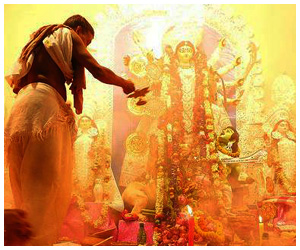
This day marks the last day of the three days magnificence. Maha Navami soon starts just after Sandhi puja and concluded by the "Maha Aarati". Many puja committees arrange recreational activities followed by Navami Bhog.
Since this is the last day of the goddess in her paternal house hence many arrangements are prepared to pamper the Goddess. It is a common Hindu belief that Devi will go back to Kailasa after Maha Nabami and she will again come back after one long year. Thus it is the day when almost every Bengali feel depressed and dejected for they are about to depart from the Goddess. It is thus almost a customary affair for the Bengali mothers present to treat Goddess Durga as their own daughters and thus pamper accordingly. Thus they feel the pain which is of same kind when their own daughter departs from her just to go to the return to her in-laws house.
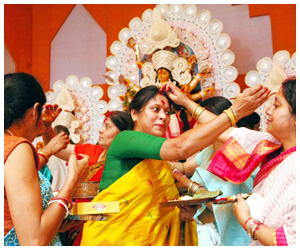
This is the final day of Durga puja when the Durga idol is taken for immersion in the holy river Ganga. The immersion process is known as 'Visharjan' where the deity is taken with grand processions on the streets. The common slogan "asche bochor abar hobe" is prevalent on every nooks and corners of the street.
And the most important ritual of this day is the “Sindur Khela” where married women play with vermillion with each other. Once the emersion is completed, people visit the homes of their relatives and friends with sweets to show respect and gratitude. Hence the whole celebration of Durga Puja comes to an end with the observance of “Bijoya Dashami".
Try out the other sections